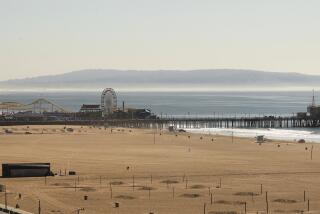Otay Reservoir Picked as Site for Olympic Training
- Share via
A two-year search for a U. S. Olympic training center site in San Diego will end with the announcement today by a local sports foundation that Lower Otay Reservoir east of Chula Vista has been selected.
San Diego Councilwoman Gloria McColl, president of the San Diego National Sports Training Center Foundation, has called a 1 p.m. news conference to announce the site chosen for the proposed year-round Olympic center and to disclose private funding pledges for the project.
McColl was unavailable for comment late Tuesday. An aide, Marla Marshall, said that McColl was en route to San Diego from Montreal, where she was attending a transit meeting. But a source close to the Olympic project confirmed Tuesday that Otay Reservoir was the selected location.
The site, on land around a San Diego city reservoir, meets the U. S. Olympic Committee’s standards in size if not in location. USOC members had asked for a site close to educational institutions, medical and commercial centers, and suitable housing for an expected 350 top athletes.
Final Decision Date
Larry McCollum, director of the Olympic training center program, said the USOC executive committee will meet Nov. 12 in Minneapolis-St. Paul to make a final decision on the San Diego group’s proposal.
McCollum, who plans to attend today’s news conference, said members of the USOC site selection subcommittee will meet with the local foundation officials Friday to review the San Diego site proposal and economic analyses before the USOC meeting next month.
The Olympic committee already has given tentative approval to San Diego’s selection as the fourth and largest training site for U. S. Olympic hopefuls, he said, and, if the final approval is given in November, the local group will be free to begin fund raising and site acquisition.
Because property around the Lower Otay reservoir is in private ownership and must be purchased, and because local use approvals and construction permits must be obtained, one local official estimated that the center could not be opened before 1991 at the earliest. USOC leaders are seeking a 90- to 150-acre site to allow for expansion of training facilities in decades to come.
Training Sites
Current Olympic training facilities are in Colorado Springs, also headquarters of the USOC; at Lake Placid, N.Y., and at Marquette, Mich.--all in cold weather locations. San Diego would be the first training site to allow outdoor training all year.
“We plan to take advantage of your wonderful climate and build as many of our facilities as possible outdoors,” McCollum said, predicating his statement on the USOC executive board’s expected approval. Outdoor eating and recreational areas and training fields will cut down the cost of construction, he pointed out.
Although no firm figures on the cost of the training center have been made public, estimates range from $8 million up to $50 million. Olympic officials have stressed that the new center should be built in an accessible urban area, where attendance by locals and tourists at the athletic events could help defray costs.
Controversy has plagued the local sports group in its search for a site, causing McColl’s group of business and civic leaders to lower a cloak of silence over the process after half a dozen locations, including Lower Otay, had been viewed and given tentative approval by Olympic committee members.
Among locations evoking local opposition were the old Navy Hospital buildings in Balboa Park, the eastern part of the UC San Diego campus in La Jolla, Lake Hodges reservoir near Escondido and Mission Trails Regional Park east of Tierrasanta and west of Santee.
More to Read
Go beyond the scoreboard
Get the latest on L.A.'s teams in the daily Sports Report newsletter.
You may occasionally receive promotional content from the Los Angeles Times.






